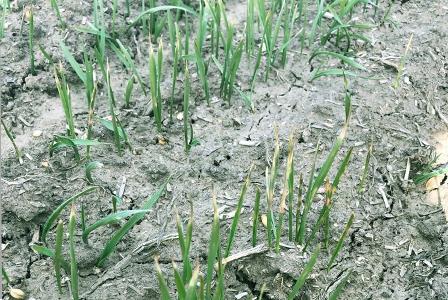Cold delays fall wheat planting, emergence

POCATELLO - Unseasonably cold and wet October weather has delayed fall wheat planting and emergence in East Idaho, potentially putting fields at risk of winter kill, said University of Idaho Extension cereals pathologist Juliet Marshall.
The good news, Marshall explained, is that the record-breaking low temperatures throughout the month in East Idaho should help keep certain diseases affecting grain in check next season.
She said the bitter cold killed off aphids and other disease-spreading insects and quashed volunteer plants that provide a "green bridge," enabling fungal pathogens such as stripe rust and barley yellow dwarf to survive into the next season.
Last month was the coldest October in East Idaho's history, according to the National Weather Service. Farmers raced to harvest their final potato fields before record low temperatures arrived early in the month.
Marshall worries farmers who have already sustained frost damage to spud crops may also have to replant a lot of their winter wheat acres in the spring.
Many farmers were too busy digging spuds and sugar beets to plant their fall wheat according to the usual schedule, and their grain fields are lagging in their progression, she said.
Marshall said the developmental delays increase the odds that wheat plants won't have the necessary crown growth to support themselves with sufficient sugar throughout the winter.
Marshall has evaluated some fall wheat fields where plants emerged and sustained frost damage, which also makes them more susceptible to winter kill.
Many fields may not sprout through the soil prior to winter, raising the risk that driving rains and lack of snow cover could create soil "crust" that could serve as a barrier to emergence.
"Normally, planting dates in this area vary from mid-September to the end of September. In a lot of cases, we're two weeks behind the normal planting window," Marshall said.
She said poor emergence could also pose erosion problems heading into next spring, given that many growers plant fall wheat in sandy soil to keep it from blowing away.
Ken Morgan, director of merchandising with Thresher Artisan Wheat, said fall wheat planting in East Idaho was well behind scheduled until the final 10 days of October, when area farmers "really jumped on it and got it done."
"My plantings overall are only down about 3 percent. Some of that is colder weather," Morgan said.
He said crop emergence, however, is way behind normal, and he, too, is concerned about the elevated prospects of East Idaho winter kill.
"You drive around and you don't see many green winter wheat fields," Morgan said.
Dale Clark, a wheat breeder who works from Idaho Falls for Nutrien, said his fall wheat trial plots in Shelley are normally emerged by Oct. 15. This season's wheat plants have yet to pop through the soil.
"In my opinion, we're going to have some emergence questions," Clark said, adding that a recent turn toward drier weather could also contribute to losses from dryness.
James Gneiting, who farms in the Osgood area northwest of Idaho Falls, has planted 400 acres of soft white winter wheat. He planted the field about two weeks later than normal and is concerned by the lack of development.
"I can't remember if I've ever had it this immature before it stopped growing," Gneiting said.
Terreton farmer Steve Shively usually plants about 700 acres of fall wheat. He only planted 200 acres this season, concerned about the cold weather.
Though Shively had his fall wheat planted before the cold spell, he's been disappointed by the poor emergence.
Idaho Wheat Commission Executive Director Blaine Jacobson said challenges with winter wheat planting don't appear to be widespread throughout the state.
He said none of the growers on his commission believe the state as a whole faces a serious problem with its forthcoming winter wheat crop.
Still can't find what you are looking for? Find by topic:
- Achievement Award (YF&R)
- Actions Alerts
- Advocacy
- Ag Ambassadors
- American Farm Bureau
- American Farm Bureau Policy Book
- Archive Photos
- Articles
- Board of Directors
- Calendar - State/District
- Calendar - County
- Capitol Reflections
- Collegiate Chapters
- Committee Application Form
- Commodities
- Convention Annual
- County Presidents & Board Information
- County Resource Page
- Delegate Form
- Discount Programs
- Discussion Meet
- Discussion Meet - High School
- Education Programs
- Events
- Excellence Award (YF&R)
- Expense Voucher
- Flickr
- Gem State Producer
- High School Discussion Meet
- High School Speech Contest
- Hope in Idaho Ag
- House of Delegates Credentials Form
- IFBF Board of Directors
- IFBF Policy Book
- IFBF Staff
- Insurance
- Legislative Action Program
- Legislative Issues
- Library
- MAC Trailer
- Magazines
- Map My Benefits
- Member Benefits
- Member Discount
- Membership Application
- Mission Statement
- Moving Agriculture to the Classroom
- Newsletter Sign up
- News Releases
- News Room
- Open Range Law
